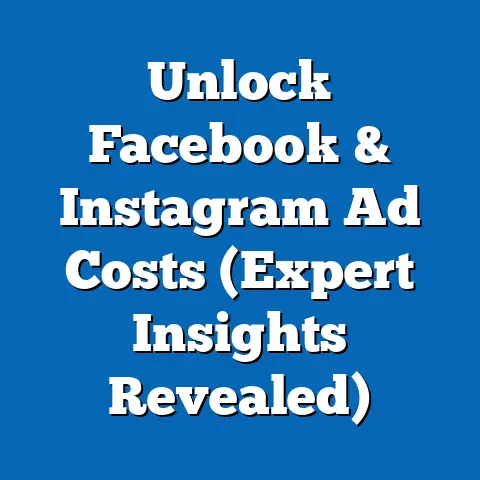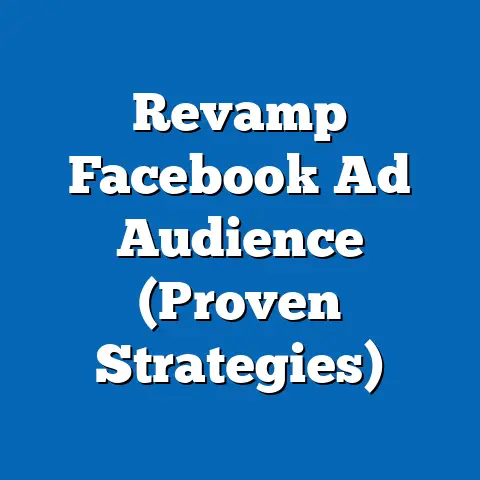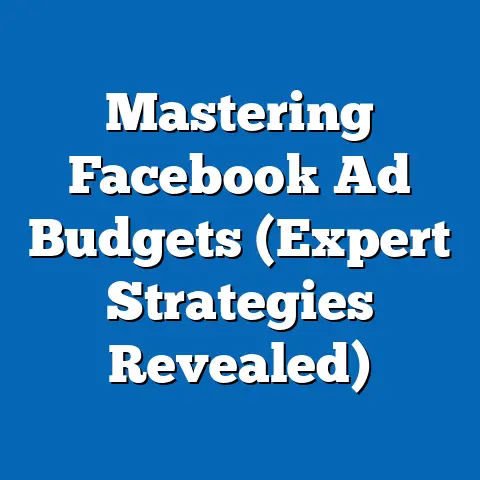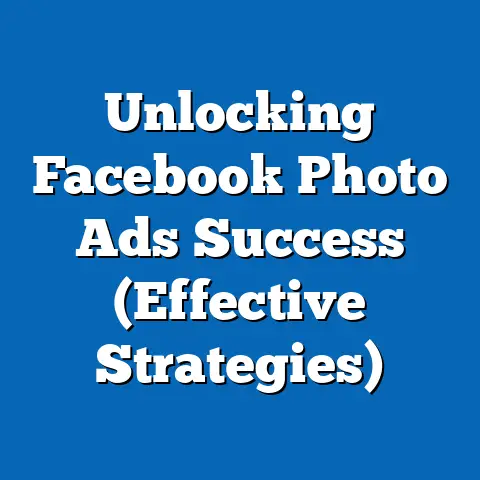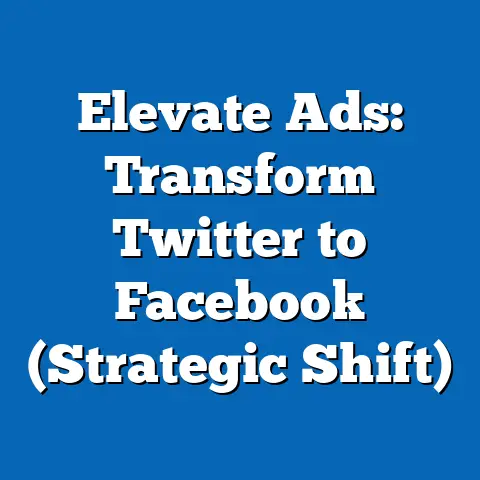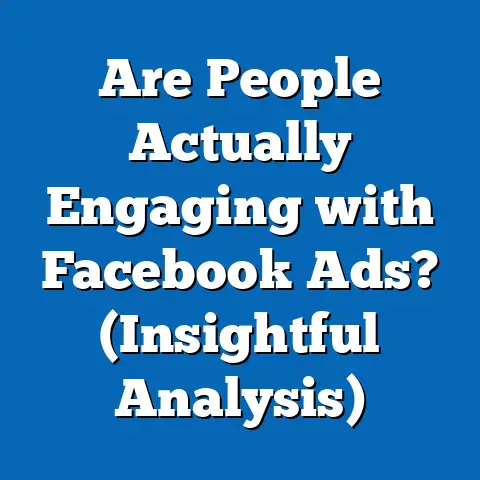Understanding Facebook Ads Pricing (Unlock Hidden Savings)
Facebook advertising. It’s a phrase that can either excite or intimidate, depending on your experience. I remember when I first started delving into the world of Facebook Ads, I felt like I was navigating a complex maze blindfolded. I quickly learned that throwing money at the platform without a solid understanding of how it works is a recipe for disaster. What I also discovered, and what many advertisers overlook, is that mastering Facebook Ads pricing can be a game-changer, not just for optimizing your ad spend, but for unlocking hidden savings that can be reinvested into strategies that actually work.
Think of it this way: you wouldn’t buy a car without understanding the different models, features, and financing options, right? The same principle applies to Facebook Ads. Many businesses, from small startups to larger enterprises, are leaving money on the table simply because they don’t fully grasp the intricacies of Facebook’s pricing model. This article is your roadmap to navigating that maze, revealing the secrets to cost-effective advertising and showing you how to unlock those hidden savings. Whether you’re a seasoned marketer or just starting out, the knowledge you’ll gain here will empower you to make data-driven decisions that drive real results.
According to Statista, global digital ad spending is projected to reach nearly \$600 billion in 2024, with a significant portion of that going to platforms like Facebook. That’s a massive amount of money, and if you’re not optimizing your campaigns, you’re essentially contributing to that number without seeing the ROI you deserve. I’ve seen firsthand how a deep dive into pricing strategies can transform a struggling campaign into a highly profitable one. It’s not just about spending less; it’s about spending smarter. So, let’s get started and unlock the hidden potential of your Facebook Ads budget.
Overview of Facebook Ads Pricing
Facebook Ads pricing isn’t a one-size-fits-all equation. It’s a dynamic system influenced by a multitude of factors. Understanding the core pricing models is fundamental to crafting a successful advertising strategy. Let’s break down the primary models you’ll encounter:
-
Cost-Per-Click (CPC): This is perhaps the most straightforward model. You pay each time someone clicks on your ad. It’s ideal when your primary goal is driving traffic to your website or landing page. For instance, if you’re launching a new product and want to generate initial interest, CPC can be a great way to get people to your product page.
-
Cost-Per-Impression (CPM): With CPM, you pay for every 1,000 impressions your ad receives, regardless of whether anyone clicks on it. This model is best suited for building brand awareness and reaching a large audience. Let’s say you’re a new local business aiming to increase visibility in your community. CPM allows you to put your brand in front of as many potential customers as possible.
-
Cost-Per-Action (CPA): This model is all about conversions. You pay when someone takes a specific action, such as making a purchase, signing up for a newsletter, or downloading an app. CPA is perfect for performance-driven campaigns where you’re focused on achieving concrete results. For example, if you’re running an e-commerce business, CPA can help you acquire new customers and drive sales.
-
Cost-Per-Engagement (CPE): CPE focuses on interactions with your ad, such as likes, shares, comments, and video views. This model is effective for boosting engagement and fostering a sense of community around your brand. If you’re launching a new social media campaign, CPE can help you encourage user interaction and build a loyal following.
Cost-Per-Click (CPC): This is perhaps the most straightforward model. You pay each time someone clicks on your ad. It’s ideal when your primary goal is driving traffic to your website or landing page. For instance, if you’re launching a new product and want to generate initial interest, CPC can be a great way to get people to your product page.
Cost-Per-Impression (CPM): With CPM, you pay for every 1,000 impressions your ad receives, regardless of whether anyone clicks on it. This model is best suited for building brand awareness and reaching a large audience. Let’s say you’re a new local business aiming to increase visibility in your community. CPM allows you to put your brand in front of as many potential customers as possible.
Cost-Per-Action (CPA): This model is all about conversions. You pay when someone takes a specific action, such as making a purchase, signing up for a newsletter, or downloading an app. CPA is perfect for performance-driven campaigns where you’re focused on achieving concrete results. For example, if you’re running an e-commerce business, CPA can help you acquire new customers and drive sales.
Cost-Per-Engagement (CPE): CPE focuses on interactions with your ad, such as likes, shares, comments, and video views. This model is effective for boosting engagement and fostering a sense of community around your brand. If you’re launching a new social media campaign, CPE can help you encourage user interaction and build a loyal following.
Beyond these models, there are two primary bidding strategies to consider:
-
Automatic Bidding: Facebook automatically sets your bids to get the most results for your budget. This is a good option for beginners or those who want a hands-off approach. The algorithm does the heavy lifting, adjusting bids based on real-time data.
-
Manual Bidding: You set your own bids, giving you more control over your ad spend. This strategy requires a deeper understanding of the platform and your target audience, but it can lead to more efficient spending if done correctly.
Automatic Bidding: Facebook automatically sets your bids to get the most results for your budget. This is a good option for beginners or those who want a hands-off approach. The algorithm does the heavy lifting, adjusting bids based on real-time data.
Manual Bidding: You set your own bids, giving you more control over your ad spend. This strategy requires a deeper understanding of the platform and your target audience, but it can lead to more efficient spending if done correctly.
The cost of your Facebook Ads campaign isn’t solely determined by the pricing model you choose. Several other factors play a significant role:
- Ad Relevance: Facebook prioritizes ads that are relevant to its users. The higher your ad relevance score, the lower your costs will be. Creating compelling, targeted ads is crucial for achieving a high relevance score.
- Audience Targeting: The more specific your audience targeting, the more competitive the bidding process can become. Targeting a broad audience might result in lower costs, but it can also lead to lower conversion rates.
- Competition: The more advertisers targeting the same audience, the higher the costs will be. This is especially true during peak seasons like holidays or major events.
- Seasonal Trends: Advertising costs tend to fluctuate throughout the year. Understanding these trends can help you plan your campaigns strategically and avoid overspending during peak periods.
Takeaway: Understanding the different pricing models and bidding strategies is the first step to unlocking hidden savings on Facebook Ads. Choose the model that aligns with your campaign goals and be mindful of the factors that influence pricing.
The Facebook Auction System
The Facebook Ads auction system is the engine that drives the platform’s advertising ecosystem. It’s a real-time, dynamic process that determines which ads are shown to which users and at what price. Understanding how this auction works is critical to optimizing your campaigns and reducing costs.
At its core, the Facebook Ads auction is a competition between advertisers vying for the same audience. When a user matches the targeting criteria of multiple ads, Facebook initiates an auction to determine which ad will be displayed. The winner isn’t necessarily the advertiser with the highest bid. Instead, Facebook considers three key components:
-
Bid Amount: This is the maximum amount you’re willing to pay for a specific outcome, such as a click, impression, or conversion. Your bid represents your valuation of the opportunity to reach that user.
-
Ad Quality: Facebook assesses the quality of your ad based on factors like relevance, engagement, and landing page experience. A high-quality ad is more likely to be shown to users and can even win auctions against higher bids.
-
Estimated Action Rates: Facebook predicts how likely a user is to take the desired action based on historical data and user behavior. Ads with higher predicted action rates are favored in the auction.
Bid Amount: This is the maximum amount you’re willing to pay for a specific outcome, such as a click, impression, or conversion. Your bid represents your valuation of the opportunity to reach that user.
Ad Quality: Facebook assesses the quality of your ad based on factors like relevance, engagement, and landing page experience. A high-quality ad is more likely to be shown to users and can even win auctions against higher bids.
Estimated Action Rates: Facebook predicts how likely a user is to take the desired action based on historical data and user behavior. Ads with higher predicted action rates are favored in the auction.
The winning ad is determined by a combination of these three factors. Facebook calculates a “total value” for each ad, and the ad with the highest total value wins the auction. This means that even if your bid is lower than your competitor’s, you can still win the auction if your ad quality and estimated action rates are significantly higher.
So, how can you leverage your understanding of the auction system to improve your ad performance and reduce costs? Here are a few strategies:
-
Optimize Ad Quality: Focus on creating compelling, relevant ads that resonate with your target audience. Use high-quality images and videos, write engaging copy, and ensure your landing page provides a seamless user experience.
-
Refine Audience Targeting: Target your ads to the most relevant users based on demographics, interests, behaviors, and custom audiences. The more specific your targeting, the higher your ad relevance score will be.
-
Experiment with Bidding Strategies: Test different bidding strategies to find the one that works best for your campaign goals. Consider using automatic bidding to start and then switching to manual bidding once you have a better understanding of your audience and ad performance.
-
Monitor Ad Performance: Regularly monitor your ad performance metrics, such as click-through rate (CTR), conversion rate, and cost-per-result. Use this data to identify areas for improvement and optimize your campaigns accordingly.
Optimize Ad Quality: Focus on creating compelling, relevant ads that resonate with your target audience. Use high-quality images and videos, write engaging copy, and ensure your landing page provides a seamless user experience.
Refine Audience Targeting: Target your ads to the most relevant users based on demographics, interests, behaviors, and custom audiences. The more specific your targeting, the higher your ad relevance score will be.
Experiment with Bidding Strategies: Test different bidding strategies to find the one that works best for your campaign goals. Consider using automatic bidding to start and then switching to manual bidding once you have a better understanding of your audience and ad performance.
Monitor Ad Performance: Regularly monitor your ad performance metrics, such as click-through rate (CTR), conversion rate, and cost-per-result. Use this data to identify areas for improvement and optimize your campaigns accordingly.
Let’s consider a practical example. Imagine you’re running an ad campaign to promote a new e-book. You’re targeting a broad audience of small business owners and setting a relatively low bid. Your competitor, on the other hand, is targeting a more specific audience of marketing professionals and setting a higher bid. However, your ad is highly engaging and relevant to your target audience, resulting in a high CTR and conversion rate. As a result, your ad wins the auction despite your lower bid because Facebook recognizes that your ad is providing a better user experience and driving more valuable results.
I’ve personally seen this play out time and again. A client of mine was struggling to compete against larger brands with bigger budgets. By focusing on hyper-relevant ad copy and laser-focused targeting, we were able to consistently outperform their competitors, even with a smaller budget. It’s a testament to the power of understanding and leveraging the Facebook Ads auction system.
Takeaway: The Facebook Ads auction is a complex system that rewards advertisers who prioritize ad quality, audience targeting, and user experience. By understanding how the auction works, you can optimize your campaigns and reduce costs.
Common Pricing Mistakes and How to Avoid Them
Navigating the world of Facebook Ads pricing can be tricky, and it’s easy to fall into common traps that can drain your budget and hinder your results. I’ve seen countless advertisers make these mistakes, and I’m here to help you avoid them. Let’s explore some of the most prevalent pricing pitfalls and how to steer clear of them:
-
Setting Unrealistic Budgets: One of the biggest mistakes advertisers make is setting budgets that are either too high or too low. A budget that’s too high can lead to overspending and wasted ad impressions, while a budget that’s too low can limit your reach and prevent you from achieving your goals.
- Solution: Start with a realistic budget based on your campaign goals and target audience. Use Facebook’s budget recommendations as a starting point and adjust your budget based on your ad performance.
-
Neglecting Audience Targeting: Targeting a broad audience might seem like a good way to reach more people, but it can also lead to irrelevant ad impressions and wasted ad spend.
- Solution: Define your target audience based on demographics, interests, behaviors, and custom audiences. The more specific your targeting, the more relevant your ads will be, and the lower your costs will be.
-
Misunderstanding Bidding Strategies: Choosing the wrong bidding strategy can have a significant impact on your ad costs and performance. For example, using manual bidding without a solid understanding of your audience and ad performance can lead to overpaying for clicks or impressions.
- Solution: Experiment with different bidding strategies to find the one that works best for your campaign goals. Start with automatic bidding and then switch to manual bidding once you have a better understanding of your audience and ad performance.
-
Ignoring Ad Relevance: Facebook prioritizes ads that are relevant to its users. If your ads are not relevant to your target audience, they will have lower ad relevance scores, resulting in higher costs and lower ad visibility.
- Solution: Create compelling, relevant ads that resonate with your target audience. Use high-quality images and videos, write engaging copy, and ensure your landing page provides a seamless user experience.
-
Failing to Track and Analyze Ad Performance: Not tracking and analyzing your ad performance data is like driving a car without a speedometer or fuel gauge. You won’t know how well your ads are performing or how much money you’re spending.
- Solution: Use Facebook Ads Manager to track and analyze your ad performance metrics, such as CTR, conversion rate, and cost-per-result. Use this data to identify areas for improvement and optimize your campaigns accordingly.
Setting Unrealistic Budgets: One of the biggest mistakes advertisers make is setting budgets that are either too high or too low. A budget that’s too high can lead to overspending and wasted ad impressions, while a budget that’s too low can limit your reach and prevent you from achieving your goals.
- Solution: Start with a realistic budget based on your campaign goals and target audience. Use Facebook’s budget recommendations as a starting point and adjust your budget based on your ad performance.
Neglecting Audience Targeting: Targeting a broad audience might seem like a good way to reach more people, but it can also lead to irrelevant ad impressions and wasted ad spend.
- Solution: Define your target audience based on demographics, interests, behaviors, and custom audiences. The more specific your targeting, the more relevant your ads will be, and the lower your costs will be.
Misunderstanding Bidding Strategies: Choosing the wrong bidding strategy can have a significant impact on your ad costs and performance. For example, using manual bidding without a solid understanding of your audience and ad performance can lead to overpaying for clicks or impressions.
- Solution: Experiment with different bidding strategies to find the one that works best for your campaign goals. Start with automatic bidding and then switch to manual bidding once you have a better understanding of your audience and ad performance.
Ignoring Ad Relevance: Facebook prioritizes ads that are relevant to its users. If your ads are not relevant to your target audience, they will have lower ad relevance scores, resulting in higher costs and lower ad visibility.
- Solution: Create compelling, relevant ads that resonate with your target audience. Use high-quality images and videos, write engaging copy, and ensure your landing page provides a seamless user experience.
Failing to Track and Analyze Ad Performance: Not tracking and analyzing your ad performance data is like driving a car without a speedometer or fuel gauge. You won’t know how well your ads are performing or how much money you’re spending.
- Solution: Use Facebook Ads Manager to track and analyze your ad performance metrics, such as CTR, conversion rate, and cost-per-result. Use this data to identify areas for improvement and optimize your campaigns accordingly.
I remember working with a client who was consistently overspending on their Facebook Ads campaigns. They were targeting a broad audience and using a manual bidding strategy without any real understanding of their ad performance. After analyzing their data, I realized that their ads were not relevant to their target audience, resulting in low ad relevance scores and high costs. By refining their audience targeting and creating more compelling ads, we were able to significantly reduce their ad spend and improve their overall ROI.
One of the most valuable lessons I’ve learned is the importance of continuous testing and optimization. Don’t be afraid to experiment with different ad creatives, targeting options, and bidding strategies. The key is to track your results, analyze your data, and make informed decisions based on what’s working and what’s not.
Takeaway: Avoiding common pricing mistakes is essential for maximizing your Facebook Ads budget and achieving your marketing goals. By setting realistic budgets, refining your audience targeting, understanding bidding strategies, prioritizing ad relevance, and tracking your ad performance, you can unlock hidden savings and improve your overall ROI.
Advanced Strategies for Unlocking Hidden Savings
Now that you have a solid understanding of the fundamentals of Facebook Ads pricing, let’s delve into some advanced strategies that can help you unlock even greater savings and maximize your ROI. These techniques require a deeper understanding of the platform and your target audience, but they can yield significant results if implemented correctly.
-
Audience Segmentation: Not all users are created equal. Segmenting your audience based on demographics, interests, behaviors, and custom audiences allows you to target your ads to the most relevant users and personalize your messaging for maximum impact.
- Custom Audiences: Create custom audiences based on your existing customer data, such as email lists, website visitors, and app users. This allows you to target your ads to people who are already familiar with your brand and more likely to convert.
- Lookalike Audiences: Use lookalike audiences to find new users who share similar characteristics with your existing customers. This is a great way to expand your reach and acquire new customers who are likely to be interested in your products or services.
-
A/B Testing: A/B testing, also known as split testing, involves creating multiple versions of your ads and testing them against each other to see which one performs best. This allows you to refine your ad creatives, targeting options, and bidding strategies based on real-world data.
- Ad Creatives: Test different headlines, images, videos, and calls to action to see which ones resonate most with your target audience.
- Targeting Options: Test different demographics, interests, behaviors, and custom audiences to see which ones yield the best results.
- Bidding Strategies: Test different bidding strategies, such as CPC, CPM, and CPA, to see which one is most cost-effective for your campaign goals.
-
Retargeting Campaigns: Retargeting involves showing ads to users who have previously interacted with your website, app, or Facebook page. This is a highly effective strategy for driving conversions and increasing brand loyalty.
- Website Retargeting: Show ads to users who have visited specific pages on your website, such as product pages or checkout pages.
- App Retargeting: Show ads to users who have downloaded your app but haven’t made a purchase or completed a specific action.
- Facebook Page Retargeting: Show ads to users who have liked or followed your Facebook page.
-
Leveraging Facebook Pixel: The Facebook Pixel is a powerful tool that allows you to track user behavior on your website and measure the effectiveness of your ad campaigns. By installing the Facebook Pixel on your website, you can track conversions, optimize your ads, and build custom audiences for retargeting.
-
Utilizing Ad Scheduling: Ad scheduling allows you to show your ads only during specific times of the day or days of the week. This is a great way to optimize your ad spend and target your audience when they are most likely to be online and engaged.
Audience Segmentation: Not all users are created equal. Segmenting your audience based on demographics, interests, behaviors, and custom audiences allows you to target your ads to the most relevant users and personalize your messaging for maximum impact.
- Custom Audiences: Create custom audiences based on your existing customer data, such as email lists, website visitors, and app users. This allows you to target your ads to people who are already familiar with your brand and more likely to convert.
- Lookalike Audiences: Use lookalike audiences to find new users who share similar characteristics with your existing customers. This is a great way to expand your reach and acquire new customers who are likely to be interested in your products or services.
A/B Testing: A/B testing, also known as split testing, involves creating multiple versions of your ads and testing them against each other to see which one performs best. This allows you to refine your ad creatives, targeting options, and bidding strategies based on real-world data.
- Ad Creatives: Test different headlines, images, videos, and calls to action to see which ones resonate most with your target audience.
- Targeting Options: Test different demographics, interests, behaviors, and custom audiences to see which ones yield the best results.
- Bidding Strategies: Test different bidding strategies, such as CPC, CPM, and CPA, to see which one is most cost-effective for your campaign goals.
Retargeting Campaigns: Retargeting involves showing ads to users who have previously interacted with your website, app, or Facebook page. This is a highly effective strategy for driving conversions and increasing brand loyalty.
- Website Retargeting: Show ads to users who have visited specific pages on your website, such as product pages or checkout pages.
- App Retargeting: Show ads to users who have downloaded your app but haven’t made a purchase or completed a specific action.
- Facebook Page Retargeting: Show ads to users who have liked or followed your Facebook page.
Leveraging Facebook Pixel: The Facebook Pixel is a powerful tool that allows you to track user behavior on your website and measure the effectiveness of your ad campaigns. By installing the Facebook Pixel on your website, you can track conversions, optimize your ads, and build custom audiences for retargeting.
Utilizing Ad Scheduling: Ad scheduling allows you to show your ads only during specific times of the day or days of the week. This is a great way to optimize your ad spend and target your audience when they are most likely to be online and engaged.
I’ve found that the most successful Facebook Ads campaigns are those that are constantly being tested and optimized. Don’t be afraid to experiment with different strategies and track your results. The key is to be data-driven and make informed decisions based on what’s working and what’s not.
For example, I worked with an e-commerce client who was struggling to generate sales through their Facebook Ads campaigns. After analyzing their data, I realized that their ads were not targeting the right audience. By implementing audience segmentation and creating custom audiences based on their existing customer data, we were able to significantly improve their ad relevance and conversion rates. We also implemented A/B testing to refine their ad creatives and targeting options, resulting in a significant reduction in their cost-per-acquisition (CPA).
Takeaway: Advanced strategies like audience segmentation, A/B testing, retargeting campaigns, leveraging the Facebook Pixel, and utilizing ad scheduling can help you unlock even greater savings and maximize your ROI on Facebook Ads.
Future Trends in Facebook Ads Pricing
The world of digital advertising is constantly evolving, and Facebook Ads pricing is no exception. As technology advances and user behavior changes, it’s important to stay ahead of the curve and anticipate future trends that could impact your advertising strategies. Let’s explore some emerging trends in social media advertising and their potential impact on Facebook Ads pricing:
-
Increased Focus on Privacy: Privacy regulations, such as GDPR and CCPA, are forcing advertisers to be more transparent about how they collect and use user data. This could lead to changes in Facebook’s targeting options and pricing models.
- Potential Impact: Advertisers may need to rely more on first-party data and contextual targeting, which could increase the cost of reaching specific audiences.
-
Rise of Artificial Intelligence (AI): AI is playing an increasingly important role in digital advertising, from optimizing ad spend to personalizing ad experiences. Facebook is already using AI to improve its ad targeting and bidding algorithms, and this trend is likely to continue.
- Potential Impact: AI-powered tools could help advertisers automate their campaigns, improve their targeting accuracy, and reduce their ad costs.
-
Growth of Video Advertising: Video advertising is becoming increasingly popular on social media, and Facebook is investing heavily in video formats like Reels and Stories.
- Potential Impact: Video ads could become more expensive than traditional image ads, but they also offer the potential for higher engagement and conversion rates.
-
Emphasis on User Experience: Facebook is prioritizing user experience and is cracking down on ads that are intrusive, misleading, or irrelevant.
- Potential Impact: Advertisers will need to focus on creating high-quality ads that provide value to users and align with their interests.
-
Integration of Augmented Reality (AR): AR is beginning to make its way into social media advertising, allowing users to interact with ads in new and engaging ways.
- Potential Impact: AR ads could offer a unique and immersive experience for users, but they may also be more expensive to create and deploy.
Increased Focus on Privacy: Privacy regulations, such as GDPR and CCPA, are forcing advertisers to be more transparent about how they collect and use user data. This could lead to changes in Facebook’s targeting options and pricing models.
- Potential Impact: Advertisers may need to rely more on first-party data and contextual targeting, which could increase the cost of reaching specific audiences.
Rise of Artificial Intelligence (AI): AI is playing an increasingly important role in digital advertising, from optimizing ad spend to personalizing ad experiences. Facebook is already using AI to improve its ad targeting and bidding algorithms, and this trend is likely to continue.
- Potential Impact: AI-powered tools could help advertisers automate their campaigns, improve their targeting accuracy, and reduce their ad costs.
Growth of Video Advertising: Video advertising is becoming increasingly popular on social media, and Facebook is investing heavily in video formats like Reels and Stories.
- Potential Impact: Video ads could become more expensive than traditional image ads, but they also offer the potential for higher engagement and conversion rates.
Emphasis on User Experience: Facebook is prioritizing user experience and is cracking down on ads that are intrusive, misleading, or irrelevant.
- Potential Impact: Advertisers will need to focus on creating high-quality ads that provide value to users and align with their interests.
Integration of Augmented Reality (AR): AR is beginning to make its way into social media advertising, allowing users to interact with ads in new and engaging ways.
- Potential Impact: AR ads could offer a unique and immersive experience for users, but they may also be more expensive to create and deploy.
As these trends unfold, it’s crucial to adapt your Facebook Ads strategies accordingly. Stay informed about the latest developments in the industry, experiment with new technologies, and prioritize user experience. By embracing change and remaining agile, you can position yourself for success in the ever-evolving world of Facebook Ads pricing.
I believe that the future of Facebook Ads pricing will be driven by a combination of factors, including privacy regulations, AI advancements, and user expectations. Advertisers who are able to navigate these challenges and leverage these opportunities will be the ones who thrive in the years to come.
Takeaway: The future of Facebook Ads pricing will be shaped by emerging trends like increased focus on privacy, the rise of AI, the growth of video advertising, the emphasis on user experience, and the integration of AR. Staying informed and adapting your strategies accordingly is crucial for long-term success.
Conclusion
Understanding Facebook Ads pricing is not just about spending less money; it’s about maximizing your advertising effectiveness and achieving your marketing goals. Throughout this article, we’ve explored the intricacies of Facebook’s pricing model, from the fundamental pricing models to advanced strategies for unlocking hidden savings.
We’ve discussed the importance of understanding the Facebook Ads auction system, avoiding common pricing mistakes, and leveraging advanced techniques like audience segmentation, A/B testing, and retargeting campaigns. We’ve also examined the potential impact of emerging trends like increased focus on privacy, the rise of AI, and the growth of video advertising.
The key takeaway is that informed decisions lead to significant financial benefits. By taking the time to understand the nuances of Facebook Ads pricing, you can optimize your ad spend, improve your targeting accuracy, and drive better results for your business.
I encourage you to take action and apply the strategies discussed in this article to your own Facebook Ads campaigns. Start by analyzing your current ad performance data and identifying areas for improvement. Experiment with different targeting options, ad creatives, and bidding strategies. And don’t be afraid to ask for help or seek out additional resources if you need it.
Remember, the world of Facebook Ads is constantly evolving, so it’s important to stay informed and adapt your strategies accordingly. By embracing change and remaining agile, you can position yourself for long-term success.
Now, I’d love to hear from you. What are your experiences with Facebook Ads pricing? What tips or strategies have you found to be most effective? Share your thoughts in the comments below or on social media. Let’s learn from each other and help each other unlock the hidden potential of Facebook Ads. The journey to mastering Facebook Ads pricing is a continuous one, but with the right knowledge and strategies, you can achieve your marketing goals and drive real results for your business.

